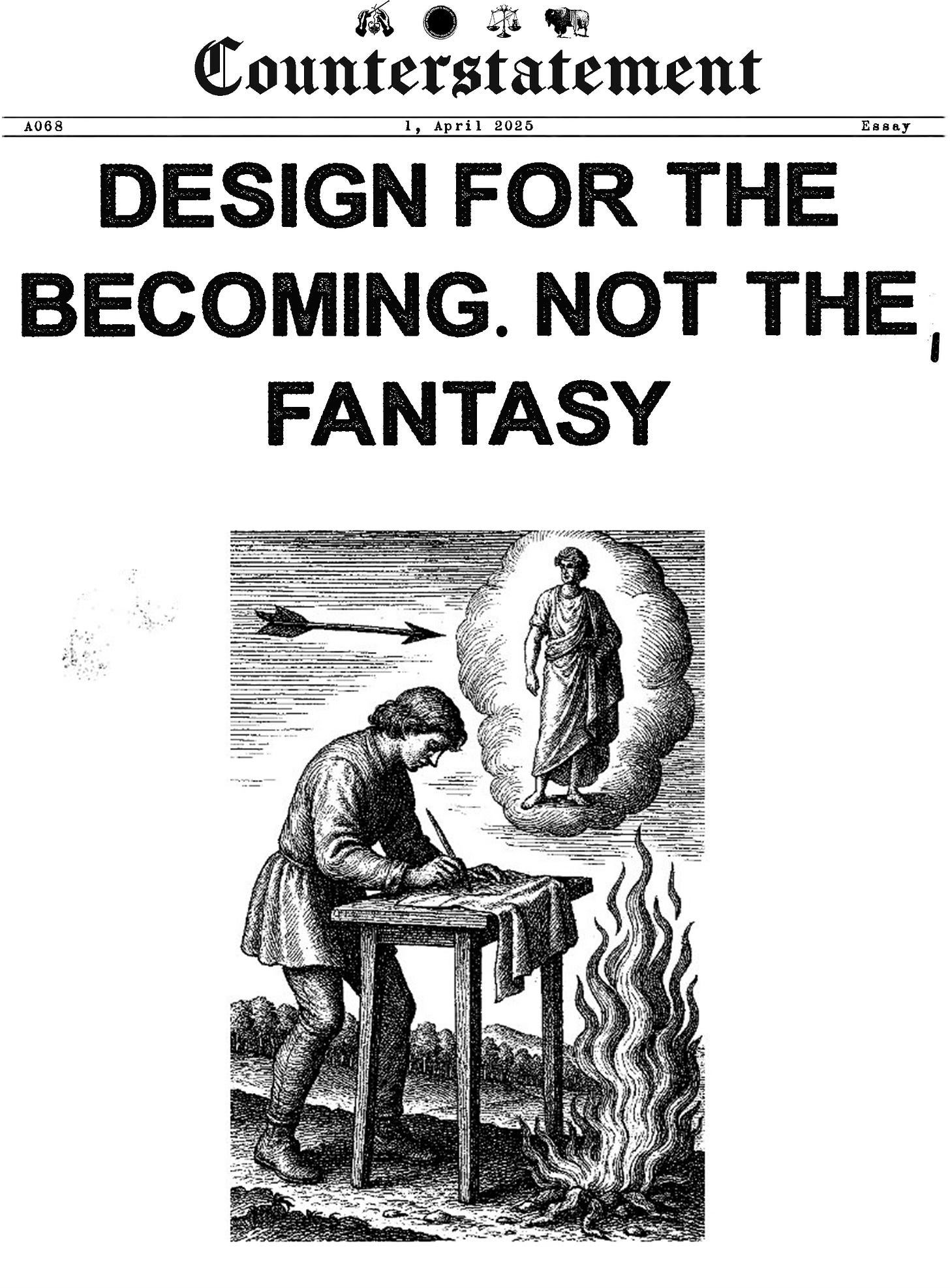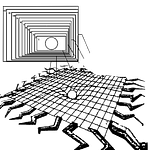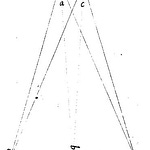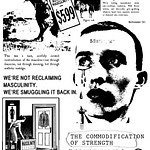“There is a crack in everything, that's how the light gets in.”- Leonard Cohen
In a world obsessed with polish, Leonard Cohen pointed to the fracture. To the rupture. To the subtle violence of becoming.
Because the real magic isn’t in perfection. Perfection is sterile. Airless. A closed system. But beauty, the kind that haunts you, doesn’t float in on symmetry, it bleeds through the broken places.
Cohen understood what most miss:
That the light, the meaning, the emotion, the myth, only enters through the crack. That beauty lives in the residue of damage, not in the fantasy of flawlessness.
This is the paradox at the heart of transformation.And in fashion, where beauty is currency and illusion often the trade, this paradox isn’t just poetic. It’s essential.Because at its peak, fashion isn’t selling image.It’s telling the story of what had to be shed, burned, or broken just to become.
Let’s go there….
Beauty is not the end result of perfection, but the residue of transformation.It is not what appears flawless, but what bears the tension of becoming.
To be truly beautiful, something must contain the ghost of its former self,it must hold the friction between what it once was, and what it aches to be.
In this tension, beauty lives.In this struggle, it speaks.
Fashion, at its most sacred, is not illusion, it is metamorphosis in material form. A garment is not just made; it is forged, in conflict, in contradiction, in pursuit. And it is this pursuit, this collapse and reassembly of identity, that gives beauty its pulse.
The Aesthetic Tension of Transformation
To transform is to struggle. To crawl from one state into another, breaking through the confines of what was, reaching, often desperately, for what could be. It’s brutal. It’s sacred. It’s never sterile.
So when a piece of fashion claims beauty, but bears no mark of that internal war, no residue of the rupture that had to occur for it to exist, it feels dishonest. Like watching someone pose in the aftermath of a fight they never actually fought.
Too smooth? Too clean? Too poised? It reeks of theater.Because beauty without struggle is just illusion.And at its highest level, fashion isn’t illusion, it’s a f*ing portal**.
The Portal vs. The Product
Let’s not confuse the two. A product is manufactured. It’s conceived to be consumed, optimized to be sold. It lives for the transaction, clean, polished, shrink-wrapped with trend forecasts and ROI projections. You pick it up, you wear it, it disappears into your closet like every other thing.
But a portal? A portal alters you. It doesn’t ask to be purchased, it demands to be crossed.It’s not just worn, it’s entered. It marks a threshold, a shift in selfhood. You come out the other side different. Not accessorized, transformed.
Portals are sacred, ancient.They’ve always symbolized transition, from youth to adulthood, from outsider to insider, from one version of the self to something bolder, stranger, more true.
In fashion, a portal might look like a coat, but it feels like armor.It might be a pair of boots, but they walk like rebellion.It might be a dress, but it clings like ritual, like rite-of-passage, like becoming.
You don’t wear a portal for the look,You wear it because it knows who you’re trying to become before you do.
Transformation is the Currency of Myth
The most iconic garments in history weren’t just garments.They were myth in material form.Think of Joan of Arc’s chainmail, Sid Vicious’s leather jacket, Prince’s purple anything. They weren’t just outfits, they were declarations. Portals into entirely new identities.
Myth doesn’t run on branding, it runs on transformation.And transformation can’t be faked.
You Can’t Fake the Rite of Passage
Here’s the brutal truth: You can’t distress your way into depth. You can’t sprinkle some faux-patina on a jacket and pretend it’s been through war. The audience may not always know why, but they’ll feel it when something rings false.
Why?
Because we can all smell costume. Costume is mimicry without memory. It imitates the signs of transformation, but it lacks the soul of it.It hasn’t suffered, it hasn’t sacrificed, it hasn’t become.
To create a portal, you must understand what the wearer is moving through.What they’re leaving behind. What they’re daring to reach for.You must design not just for the body, but for the threshold it’s about to cross.
Because when someone puts on your design, they aren’t just covering their body, they’re crossing into a new version of themselves. You are dressing their liminality.
And liminality is sacred.It’s terrifying, electric, unmoored.It’s the in-between space where identity collapses, and something new begins to take shape.
So don’t design just for form. Design for becoming. Create garments that act as thresholds, not trends.
Fashion should guide people through the liminal space of transformation. It should dress not just the body, but the becoming. It should mark the moment when they’re no longer who they were, but not quite yet who they will be. That’s the power of a threshold. That’s what makes a garment unforgettable.
Symbiosis, Not Resolution
The most powerful beauty doesn’t tie itself into a neat little bow. It doesn’t resolve.It holds tension. It carries contradiction.It stands in that delicate, dangerous space between what is whole and what is still breaking.
Real beauty isn’t about choosing clarity over complexity.It’s about allowing opposites to live in the same skin.The broken and the refined. The sacred and the profane. The ache and the aspiration.
This isn’t equilibrium. This is symbiosis, a coexistence that doesn’t cancel itself out, but feeds off the friction. One element isn’t fixed by the other. They survive because of each other.The ideal wouldn’t shimmer so violently if the ache beneath it wasn’t still pulsing. And the ache wouldn’t mean anything without the vision it’s reaching for.
Designing in the In-Between
The designer’s role isn’t to tidy this tension up, it’s to hold the space.Not to resolve the war between identity and desire, but to make it wearable.To let the garment become a liminal vessel, one that carries both what the wearer has been, and what they are daring to become.
This is where form becomes feeling.
Because a piece that is too resolved, too polished, too “complete,” doesn’t move us, it closes the door.But a piece that feels like it’s trembling? Teetering between collapse and ecstasy? That’s where the visceral charge lives.That’s the kind of beauty that isn’t just admired, it’s felt.
The Ideal Must Coexist with Its Cost
Too often, fashion sells the ideal without the journey. The dream without the damage. The divinity without the damnation.But that’s not honest. And it’s not beautiful either.
The aspiration must carry the echo of what had to be sacrificed to reach it. The glamour must whisper of grief.The silhouette must imply what it had to shed to exist at all.
That’s when fashion stops being fantasy and starts becoming myth.Not something you scroll past, but something you sense.Not something you wear to be seen, but something you wear to become.
If There’s No Tension, There’s No Pulse
If your garment doesn’t feel like it’s caught mid-transformation, if it doesn’t hum with that raw edge between becoming and unraveling, then what are we even doing here?
Design like the piece is holding its breath.Like it’s unsure whether it’s collapsing or blooming.Like it knows it’s beautiful, but still remembers what it cost to get there.
Because that’s what makes beauty unforgettable.Not its polish.But its pulse.
Designing the Pursuit, Not Just the Persona
Before you design the garment, you must understand the dream.Before you sketch the silhouette, you must know what it costs to become that silhouette.
It starts here: once you’ve identified the ideal character your brand or garment is reaching toward, the aspirational archetype, the divine masculine, the seductive libertine, the mysterious intellectual, you must go further. You must ask:
What is the process of becoming this person?
Because people don’t just wake up as these romanticized figures. They become them. Slowly, painfully, definitely. Through contradiction. Through resistance. Through pursuit.
Without the Pursuit, the Persona is Hollow
Design without this understanding becomes aesthetic cosplay.It may look refined, dangerous, powerful, but it feels empty. Because there’s no tension beneath the surface. No scar tissue. No weight.
Take Haider Ackermann at Tom Ford, for example. His garments for men evoke a pantheon of beautifully constructed male archetypes:
The elegant businessman in a mohair sweater and crocodile-trimmed coat
The rebellious libertine in leather
The minimalist mystery man in rock-star tailoring
They’re technically perfect. The tailoring is sublime. The silhouettes are commanding. But something essential is missing: the ache of becoming. The process that should haunt these characters isn’t present in the way they move, the way they inhabit the clothing.
The rebel doesn’t have a cause. The businessman has never filed taxes.The rocker has never picked up an instrument.
They are dressed in the destination, but divorced from the journey.
And the audience can feel it.
The Audience Doesn’t Crave the Ideal, They Crave the Climb
What people connect to is not just the aesthetic of aspiration.They want to feel the friction of the climb, the cost of the identity.
Because that’s where the emotional connection happens:
Not in the clean lapel of the power suit, but in the tension in the shoulders of the man trying to become powerful.
Not in the perfect hem of the rebel’s leather pants, but in the energy of someone still on the verge of breaking away.
Not in the silence of the minimalist, but in the chaos he’s trying to contain.
If you don’t design for the tension, you’re not designing for transformation. And if you’re not designing for transformation, you’re not making fashion.You’re making costumes.
Aestheticize the Process, Not Just the Persona
As a designer, your job isn’t to just clothe the ideal. It’s to reflect the pursuit of the ideal. To design garments that understand the friction of becoming.
Ask:
What internal war must this person wage to wear this garment truthfully?
What longing lives in the lining? What rebellion sits in the seam?
What past self is this outfit trying to outrun?
Because when you tap into that, when you design the pursuit, not just the persona, you inject life into the garment. You give it memory, even if it’s new. You give it purpose, even if it’s aesthetic.
And the audience will feel it,Even if they can’t explain why.
Final Thought: Fashion as Embodiment, Not Roleplay
The most powerful garments are not worn like costumes.They are inhabited.They are the skin the character has earned.
So if your design doesn’t carry the tension of the journey,if it doesn’t reflect the heat of the chase, the effort of transformation,then it may look like fashion, but it feels like fiction.
And fiction without truth,Is just forgettable.














Share this post